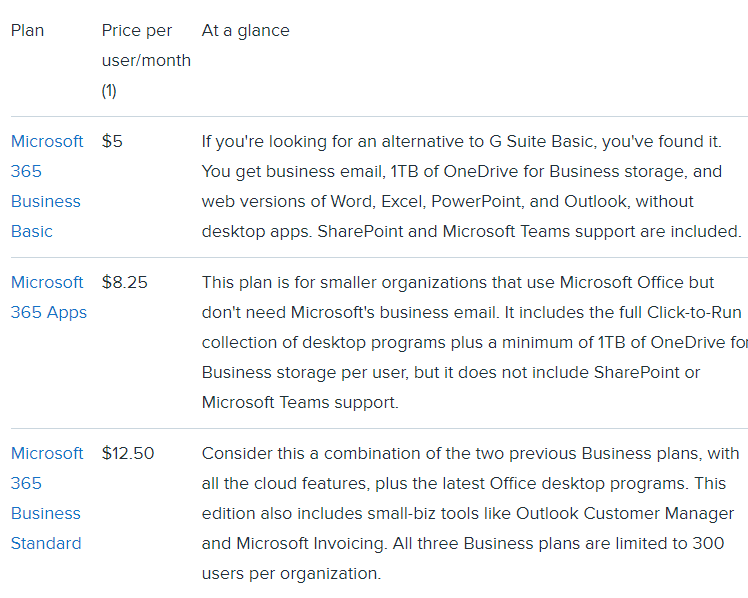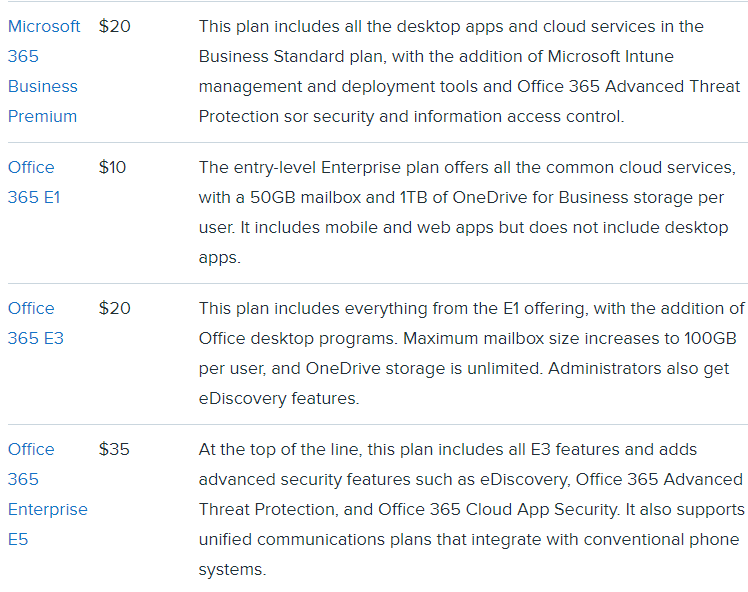Microsoft 365 vs Google Workspace : Which productivity suite is best for your business?
- The Tech Platform

- Jan 25, 2021
- 7 min read
Microsoft and Google are engaged in a pitched battle to win over your business with suites of cloud-based productivity software and services. Here's a look at the many different editions of Microsoft 365 and Google Workspace, along with what you can expect to pay for each one.
(Google updated the name of its G Suite service to Google Workspace in October 2020 and added one new plan to its lineup. This article has been updated to include details of the new plan.)
Both Microsoft and Google would like to be your one-stop shop for business productivity software. Their respective subscription offerings, Microsoft 365 and Google Workspace, tick all the top-level boxes on your company's communications and productivity checklist. Each suite includes the following features:
Business email and shared calendaring services attached to custom domains
Online storage, with shared space for collaboration and a large allotment of personal storage space for each user account
Productivity apps for creating and collaborating on documents, spreadsheets, and presentations
Corporate communication tools, including messaging, online meetings, and video conferencing
A management interface, with advanced features such as compliance and archiving for enterprise customers as well as security features including two-factor authentication
Both of these services are underpinned by a robust, highly reliable cloud infrastructure with data centers worldwide.
The two companies dominate the market for enterprise productivity software, with a handful of much smaller competitors, including Zoho Workplace, far behind.
Despite the superficial parity in features, Microsoft 365 and Google Workspace take distinctly different approaches in terms of cloud architecture and app design. For many, the choice comes down to which of those approaches fits best with your installed base of hardware.
Microsoft's approach builds on its blockbuster Office franchise (the name change from Office 365 to Microsoft 365 was effective earlier this year). and the accompanying desktop apps, which are now available in Click-to-Run packages that update automatically. The back-end services, including Exchange Online, OneDrive for Business, SharePoint Online, and Microsoft Teams, offer an easy migration path for organizations ready to move their on-premises servers to the cloud. Employees can access those services using familiar desktop apps like Outlook, Word, Excel, and PowerPoint, or they can use web-based alternatives.
By contrast, Google's approach is cloud-native and browser-centric. The web-based services are identical to the personal tools your employees are already familiar with, including Gmail, Google Drive, Google Docs, and Google Sheets. When used with Google's Chrome browser, those apps support offline storage of email and documents
Both services include web-based management consoles that are designed for mid-sized business and larger. Those management tools can be intimidating in smaller businesses that don't have a full-time IT department. For those scenarios, working with a reseller who's been certified as a Microsoft 365 or Google Workspace specialist is usually the best option.
Note that this guide covers Microsoft 365 Business and Enterprise plans, as well as Microsoft 365 offerings that include those plans. This guide does not cover Microsoft 365 Home and Personal options, which lack support for custom domains and are managed by individuals rather than organizations.
PACKAGES AND PRICES
For a striking demonstration of the difference between Google's world and Microsoft's, look no further than the lineup of plans available for purchase.
Google, true to its keep-it-simple roots, has four Google Workspace plans (an increase of one from the GSuite days): Business Starter ($6 per user per month), Business Standard ($12 per user per month), Business Plus ($18 per user per month), and Enterprise (previously $25 per user per month, but now listed as "call for pricing").
Microsoft 365, by contrast, is available in a dizzying array of permutations: three plans aimed at small businesses (Business Basic, Business Standard, and Business Premium), plus the Microsoft 365 Apps package that includes only the desktop apps and cloud storage; a handful of Office 365 Enterprise plans that haven't been rebranded; and three Microsoft 365 Enterprise plans for larger organizations transitioning away from per-machine licensing and on-premises servers. There are separate Microsoft 365 plans for educational institutions, U.S. government agencies, and nonprofit organizations.
Monthly per-user prices for Microsoft 365 plans range from $5 to $57 per user per month (the most expensive package also includes licenses for Windows 10 Enterprise E3 and Enterprise Mobility + Security E3). And if none of those plans suit your needs, you can mix and match individual services to create a custom plan.
It's difficult to make head-to-head comparisons between the two services, although there are some similarities. Most Microsoft 365 plans cost more than their Google Workspace counterparts because of the inclusion of Office desktop apps, a feature that adds about $8 a month to the per-user subscription fee. The $12-a-month Google Workspace Business plan, for example, matches most of the cloud- and browser-based features of Microsoft 365 Business Premium, which costs $20 a month and includes the full collection of Office desktop apps.
All G Suite plans include:
Gmail for Business
Meet (video and voice conferencing)
Chat (secure messaging)
Shared calendars
Google Docs, Sheets, and Slides
Keep (shared notes)
Forms (survey builder)
Sites (website builder)
Currents (the replacement for Google+ for Google Workspace)
At least 30GB of cloud file storage (Google Drive)
Security and administrative controls
Google Workspace Business Premium and Enterprise plans significantly increase cloud storage (at least 5 TB per user) and add eDiscovery and email options as well as the ability to limit user access by geographic regions, among other features.
Table 1: G Suite plans at a glance
All Microsoft 365 plans include either a set of cloud-based features or the right to download and install Office desktop apps on up to 15 devices per user (five Windows PCs or Macs, five tablets, and five smartphones), or both.
The collection of desktop apps includes Outlook, Word, Excel, PowerPoint, and OneNote (Access and Publisher are available on Windows PCs only), as well as 1TB or more of storage per user in OneDrive for Business and access to the web-based versions of Word, Excel, PowerPoint, and OneNote.
Cloud-based services include the following:
Exchange Online email hosting with a maximum inbox size of 50 or 100GB
Web-based versions of Word, Excel, PowerPoint, and Outlook
A minimum of 1TB of OneDrive for Business file storage per user
SharePoint Online team sites
HD video conferencing
Online meetings (Skype Meeting Broadcast or Microsoft Teams live events)
Secure messaging and collaboration (Microsoft Teams)
Security and administrative controls
Business plans include an appointment-scheduling app, Microsoft Bookings, and MileIQ expense-tracking software. (Two business utilities previously available in business plans, Outlook Customer Manager and Microsoft Invoicing, were retired in early 2020.)
Enterprise plans include team-based task management software (Microsoft Planner), advanced analytics (MyAnalytics and Power BI Pro), process management tools (Power Apps and Power Automate), additional collaboration software (Yammer), and advanced features such as eDiscovery, email retention policies, Microsoft Advanced Threat Protection, and free deployment support on purchases of 150 seats or more.
Confusingly, Microsoft still sells its Office 365 Enterprise plans, which don't include Windows 10 licenses or advanced management tools. The table below includes those Office-only plans.
Table 2: Microsoft 365 and Office 365 plans at a glance
(1) Monthly prices shown in this table require an annual commitment; month-to-month prices are higher.
HOW THEY COMPARE
Both Microsoft 365 and G Suite have impressively long feature lists. In fact, the biggest differences between the two services are not whether a particular feature exists but how it's implemented, and invariably that comes down to the difference in style between the two services.
Microsoft has Exchange Online, optimized for use with the Outlook desktop client. Google has Gmail, optimized for use in the Chrome web browser and on mobile apps. Aside from those fundamental architectural differences, the feature set includes just about everything a corporate email administrator would want, including anti-malware protection, spam filtering, and group aliases.
Google Workspace Business Starter accounts have a maximum inbox size of 30GB (or less, because that space is shared by the user's Drive storage). That limitation goes away with the Google Workspace Business Standard, Business Premium, and Enterprise plans. Office 365 mailbox sizes are capped at either 50GB or 100GB, depending on the plan. For Enterprise accounts with archiving turned on, archive mailbox storage is unlimited.
Productivity apps
Google's flagship productivity apps are designed to work exclusively in a browser or in one of its mobile apps. By contrast, the most popular Microsoft 365 plans include the latest release of the Office desktop applications (Outlook, Word, Excel, PowerPoint, and OneNote) on Windows PCs and Macs, in addition to increasingly full-featured web versions of those core apps.
Availability of those Office desktop apps is the killer feature for some organizations. That's especially true when fidelity with Office document formats is crucial. It's easy enough to import and export Google Docs and Sheets, but Office document features aren't guaranteed to survive round trips between the two environments.
In organizations where those formats are not a big deal and where a younger workforce has grown up with Gmail and Google Docs, the browser-based interface might be considered a plus.
Cloud storage
OneDrive for Business, once a clunky spinoff from SharePoint, now shares the same sync engine as its consumer counterpart and has matured into a reliable service that's well integrated with both Microsoft 365 and Windows, although it also works well on Macs and on mobile devices. By default, every OneDrive for Business user gets 1TB of personal cloud file storage; that limit is removed on Enterprise accounts with at least five users. For all account types, the organization gets 1TB (plus 10GB per user) of SharePoint storage.
As noted earlier, Google Drive storage allocations are shared with Gmail. On Basic accounts, that total is 30GB. The limit increases to 1TB on upgraded accounts and is unlimited for G Suite Business and Enterprise plans with at least five users. Administrators can control offline access using device policies and can dictate whether users can sync Drive files to computers or mobile devices.
Communication and collaboration
Regardless of whether you use Google Workspace or Office 365, you have an assortment of communication and collaboration tools from which to choose.
Both services allow simultaneous editing of documents in the web browser, so that people can work as a team on shared projects; for files stored on OneDrive, you can collaborate using the Office desktop apps, as well.
Google has renamed its Google Hangouts apps to Meet (for online meetings, video conferencing, and voice calls) and Chat (which handles simple text chats). Microsoft 365 accomplishes the same goals with the Microsoft Teams app, which replaces Skype for Business and the ancient Lync.
Source: paper.li










Comments